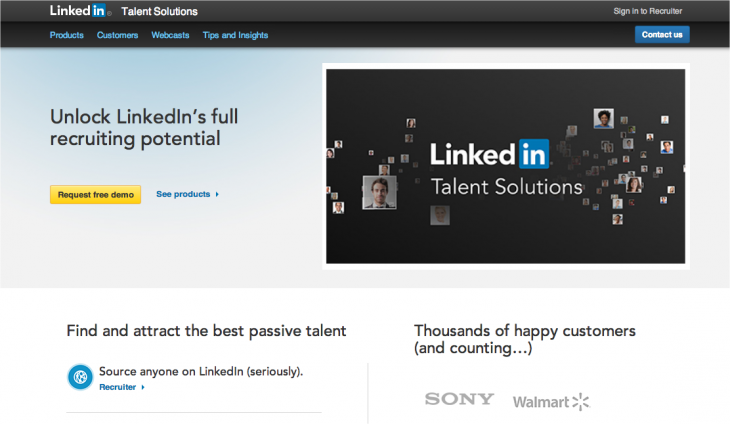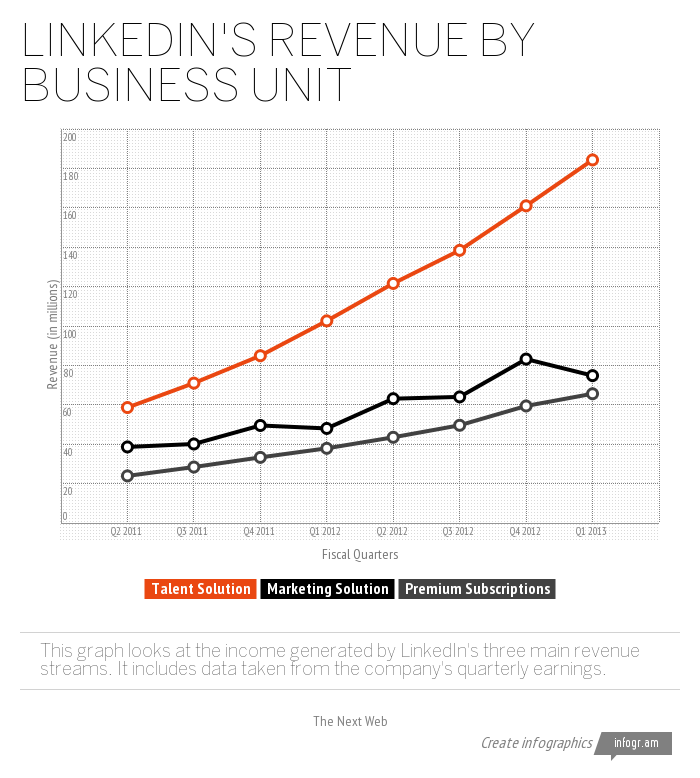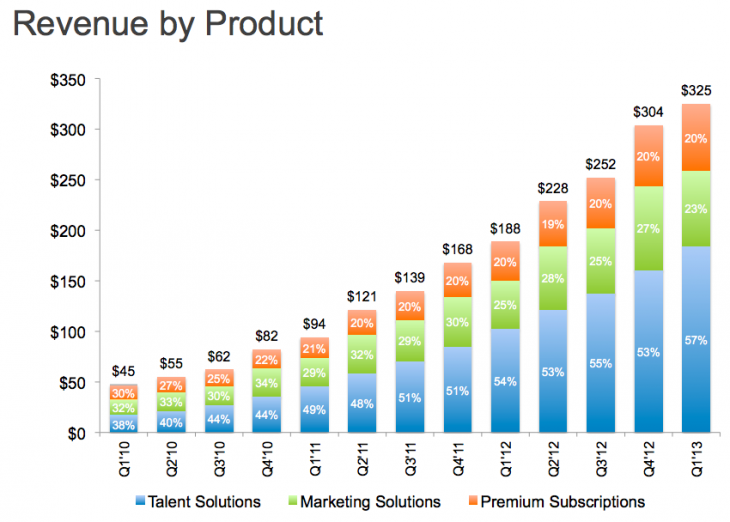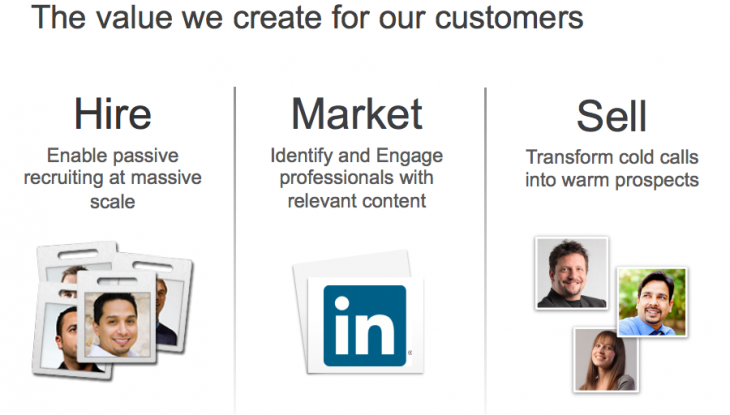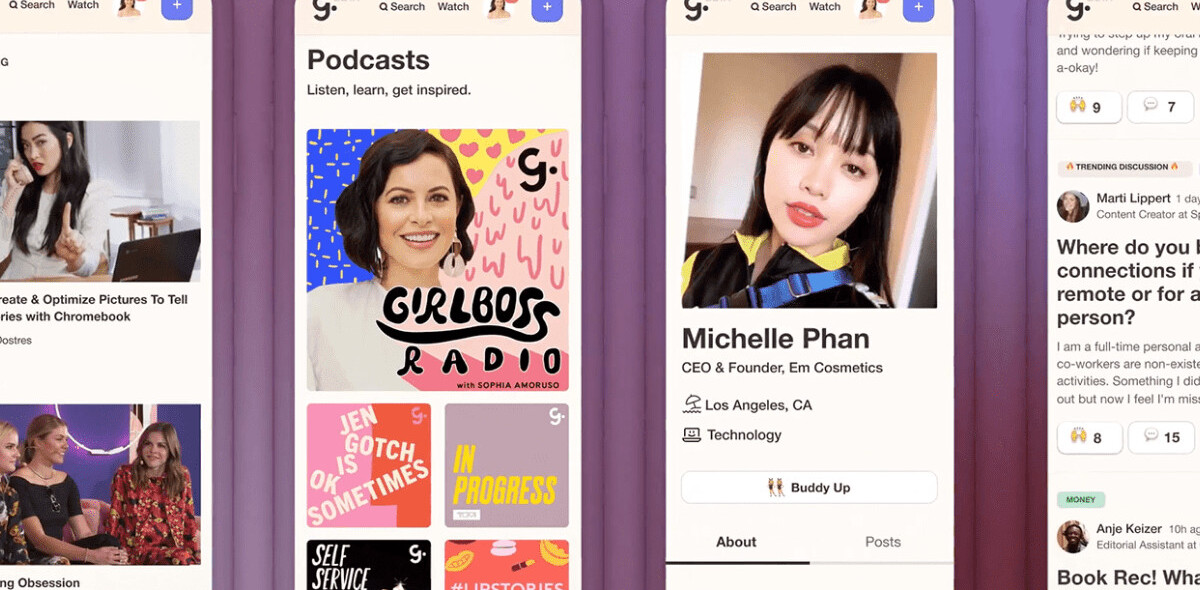
Last week, LinkedIn announced its Q1 2013 earnings, beating Wall Street’s expectations by bringing in revenue of $325 million. During a follow-up conference call, CEO Jeff Weiner said that the company’s three “diverse” revenue streams performed well, with its Talent Solutions service playing a big part bringing income to the business-focused social network. This quarter, it represented 57 percent of LinkedIn’s total revenue.
Looking back at the past eight quarters of the company’s earnings, out of the three revenue streams, Talent Solutions is the one that has been the main source of money for the company, trumping its other business units: Marketing Solutions and Premium Subscriptions.
Originally referred to as Hiring Solutions, LinkedIn’s Talent Solutions has been described as the company’s “top operating priority.” It’s one of the original business units that was rolled out soon after LinkedIn first launched. The service is one whereby recruiters and corporations can pay LinkedIn for premium features to connect with potential candidates.
During the company’s Q1 2013 earnings call, Weiner said that the service now has more than 3,700 employees working Talent Solutions spread out across 26 cities around the world.
In the above graph, we looked at the amount of revenue Talent Solutions brought into the company compared to Marketing Solutions and Premium Subscriptions. For the past eight quarters, Talent Solution has consistently exceeded the other business units and while it has continuously increased, the other offerings have had various highs and lows.
Another way to look at the impact Talent Solution has on LinkedIn’s financial position is by its percentage spanning the past three years:
Trends influencing the hiring industry
Finding the right people can be difficult. Recruiters are always on the lookout for tell-tale signs to help understand who is itching to leave or has shown any behavior indicating that they wish to at least explore new opportunities.
We had a chance to speak with LinkedIn about these trends and the company says that there are three that have really helped shape its offering:
Passive candidate recruitment
In the hiring industry, there are those workers who are “passive candidates” — those who are not currently looking for a job, but if the right one comes their way, they might be inclined to pay attention. LinkedIn says that the previous method of recruiters going onto job boards and posting opportunities while praying someone would respond no longer works.
The company says that 80 percent of the workforce is passive and that with the introduction of social networking, it’s much more possible for recruiters to explore whether someone is looking for work or not.
Talent branding
Companies need to find ways to promote themselves — not just from a product standpoint. In this day, those businesses looking to bring on new talent must actively market themselves as a great place to work and attract talent. Just because a company launched a great product doesn’t necessarily mean that it’s an excellent place to work or that people will notice that there are open positions.
LinkedIn believes that if companies have a strong talent brand, it’s possible to reduce the cost per hire rate by 25 percent, although they didn’t specifically say how this is possible. The social networking company also has a Talent Brand Index available on its site to share company comparisons.
Internal hiring
Going to the heart of one of LinkedIn’s core strengths, companies are beginning to see that their employees’ “little black books” are becoming democratized. This trend is showing that companies cannot rely solely on their human resource department to scour the Web to find the right talent. Instead, employees are being tapped to help bring in referrals and share who they know and how are they connected to certain individuals.
The backbone of Talent Solution
To address the above trends and to help LinkedIn appeal to more than just employees, Talent Solution comes with several specific features:
Recruiter
With this, companies can run a more effective search in finding the right people. If you think about the power of LinkedIn, it can be a bit more beneficial than by going through a service like Taleo, Jobvite, or other job hunting services and even other recruiting sites like Monster and CareerBuilder. The advantage here is that human resource personnel can post jobs and use LinkedIn’s filtering to find the right candidate and reach out to them if they’re looking for work.
When we spoke with LinkedIn, it shared that companies are becoming smarter when it comes to marketing not only open job positions, but also itself — these things are being treated like products and services. The old way of hiring is no longer efficient or as successful as it could be.
Last month, the company unveiled a new Recruiter homepage that gives headhunters and human resource professionals the opportunity to conduct better research on potential employees. The new look and feel was made to match LinkedIn’s site, which was redesigned a few months ago.
Elizabeth Burstein, LinkedIn’s Product Manager, said the company sought to create a tool that would function like a consumer app in the front, but provided a powerful and rich feature set of an enterprise tool in the back. In other words, LinkedIn wanted to make it possible for recruiters to be able to use the service almost like they do if they were a job seeker — the familiarity of the interface would help to make it a much better experience.
Through the use of Recruiter, companies can go conduct a more thorough search of LinkedIn’s 225 million member database to find the ideal candidate for any job. It also offers the ability to contact potential hires through the use of its InMail messaging tool. Lastly, it gives recruiters a system to better monitor, track, and manage talent that is being scouted or might fit the profile needed.
Jobs
With its Jobs service, LinkedIn will enable companies to promote their jobs. It will not only personalize jobs to appear on the Homepage, employee profile, or the company’s career page when targeted towards specific LinkedIn users. By doing so, companies can appeal directly to the people that the positions would be interesting for.
In February 2013, LinkedIn updated its Jobs service for consumers with not only a brand new creative look, but more features that will help users find jobs more appealing to them by country, zip code, industry, and function. It’s probably not that far-fetched to believe that any search query entered into LinkedIn wouldn’t be tied back to its Jobs feature within Talent Solution to help improve targeting.
And with consumers already receiving emails and notifications on LinkedIn about “Jobs you may be interested in”, being able to show relevant jobs is important to avoid wasting everyone’s time. After all, if the candidate is a marketing manager, it wouldn’t be a good use of the service if positions for a car mechanic or accountant was displayed, right?
Additionally, the Jobs feature in Talent Solution offers recruiters the ability to bid for top-rated ads. By this, it operates like Google AdWords — through this auction method, companies can bid for premium placement of open positions in its personalized job recommendations feature.
Career Pages
Simply having a recruiter scour through LinkedIn’s millions of user records isn’t enough. While companies take a proactive approach to finding talent, they still need to be reactive and have an presence on the social network for those who are looking and visit the business profile. If they’re interested, users must be able to quickly view all job openings without needing to do any further searches — this will minimize the risk of a competitor hiring them.
Value for companies
For LinkedIn’s millions of users, one of the most common things people understand about the social network is the ability to connect with peers, executives, and thought-leaders, no matter whether they’re shopping for work, interested in partnerships, or maybe just to keep in touch because they love to network. But what some might not know is that while getting to know each other is great, LinkedIn wants to be a service designed to help people find work.
But a service cannot be just about consumers, especially those that may not have a propensity to pay a fee to use the service. But companies are willing and they have been for the past decade.
After LinkedIn’s Q1 2013 earnings, the company released a document that illustrated what it does for its customers. These are not potential employees, but rather the companies who were looking to the social network for a new hiring paradigm:
Based on the performance by Talent Solutions, LinkedIn’s performance shows that it has been giving its customer companies value. However, as more people are on mobile devices, how will LinkedIn better serve ads and help improve their targeting?
Right now, the global economy is not the best that it could be in. The unemployment rate is still rather high, especially in European countries and in some parts of the United States. With millions of people out of work and looking, the numbers can possibly frighten recruiters in terms of how to scour through them and pick the best ones.
So far, Talent Solution has become a big hit at LinkedIn — but what else will the company do to keep it on its course and not let it become complacent?
See also: LinkedIn is 10 years old today: Here’s the story of how it changed the way we work
Photo credit: Main image via Spencer Platt/Getty Images, job interview image via Chris Hondros/Getty Images, LinkedIn screenshots via LinkedIn
Get the TNW newsletter
Get the most important tech news in your inbox each week.
